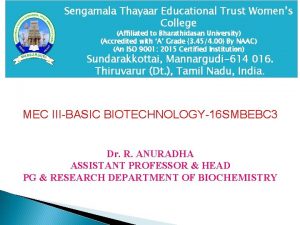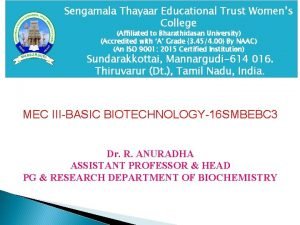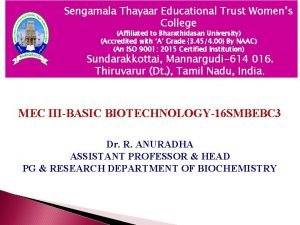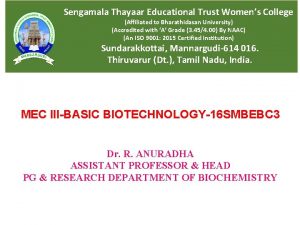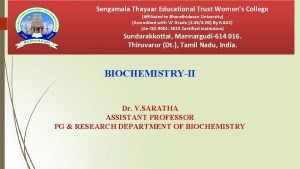Sengamala Thayaar Educational Trust Womens College Affiliated to





















- Slides: 21

Sengamala Thayaar Educational Trust Women’s College (Affiliated to Bharathidasan University) (Accredited with ‘A’ Grade {3. 45/4. 00} By NAAC) (An ISO 9001: 2015 Certified Institution) Sundarakkottai, Mannargudi-614 016. Thiruvarur (Dt. ), Tamil Nadu, India. MEC III-BASIC BIOTECHNOLOGY-16 SMBEBC 3 Dr. R. ANURADHA ASSISTANT PROFESSOR & HEAD PG & RESEARCH DEPARTMENT OF BIOCHEMISTRY

ETHANOL PRODUCTION FROM BIOMASS

SYNOPSIS: ØINTRODUCTION ØBIOCHEMISTRY OF ETHANOL FERMENTATION ØINDUSTRIAL PRODUCTION OF ETHANOL *FORMULATION OF MEDIUM *DESIGNING OF FERMENTATION SYSTEM *CULTURE OF MICROBES IN FERMENTER *RECOVERY OF ETHANOL ØAPPLICATION OF ETHANOL

INTRODUCTION: v. Ethanol, also called alcohol, ethyl alcohol and grain alcohol, is a clear, colourless liquid and the principle ingredient in alcoholic beverages like beer, wine or brandy. Because it can readily dissolve in water and other organic compounds, ethanol also is an ingredient in a range of products, from personal care and beauty products to paints and varnishes to fuel. v. Ethanol is a natural byproduct of plant fermentation and also can be produced through the hydration of ethylene.

v Ethanol is prepared from the following wastes and plant products: ü Sugarcane molasses ü Cane juices ü Sugar beets ü Cassava ü Maize ü Corn ü Crop wastes

v Carbohydrates are fond locked in wastes. The complex polysaccharides are converted into simple sugars. v It is carried out by Closteridium thermocellum, C. thermohydosulphuricum and C. thermosaccharolyticum. v The simple sugars are converted to ethanol by Zymomonas mobilis, Thermoanerobacter ethanolicus, etc. , v Some microbes are produce ethanol directly from carbohydrate wastes. Eg, Monilia, fusarium.

BIOCHEMISTRY OF ETHANOL FERMENTATION:

INDUSTRIAL PRODUCTION OF ETHANOL: üFormulation of medium üDesigning of fermentation system ücultures of microbes in fermenters üRecovery of ethanol

FORMULATION OF MEDIUM: v. The sugar concentration of cane molasses and of other carbohydrates in the waste is diluted to 10 – 18 %. This sugar concentration favors the growth of the micro organisms. v. Ammonium sulphate or ammonium phosphate is added to the diluted medium. v. The p. H of the medium is adjusted to 4 - 5 to using dilute sulphuric acid.

v. The starchy media like corn, rye, and barley are hydrolyzed with dilute acids before they are pumped into the fermenter. v. The hydrolysis of starchy yields simple sugars which are directly converted to ethanol. v. Sometimes starchy feed stock is treated with amylase enzyme, extracted from Aspergillus and Rhizopus. v. Amylase convert the starch into 80% maltose and 20% dextrin that can easily be converted into glucose.

DESIGNING FERMENTATION SYSTEM: v. The fermentation system consists of, ü Three molasses tank ü Three seed tanks ü A fermenter ü Wash camber ü Molasses storage tank


v. The stored molasses enter another tanks where the molasses are diluted properly with water. v. The diluted molasses then enter the sterilization tank for sterilization. v. The sterilized medium is used to carry out fermentation. v. The fermenter is connected with wash chamber by a pipeline. v. Harvested broth is transferred to the wash chamber for distillation.

CULTURE OF MICROBES IN FERMENTER: v. Sterilized medium in the sterilization tank is pumped into the fermenter then microbial inoculum is pumped into the fermenter to carry out ethanol fermentation. v 330 k temperature is found to be suitable for fermentation. v. Ethanol fermentation is complete in about 3 days.

v. The enzyme invertase of Zymomonas (yeast) converts sucrose in the molasses into glucose. v. This glucose is converted to ethanol by the enzyme zymase.

RECOVERY OF ETHANOL: v The fermented broth in the fermenter is known as wash. v It is distilled in the washed chamber to recover ethanol. v The distillation setup is called coffey still. v It consists of 2 column, ü Analyser ü rectifier


v Wash flowing through a folded pipe is heated in the rectifier. This pipe releases the contents at the top of the analyser. v Steam is passed through the base of the analyser to carry the alcohol vapour to the base of the rectifier. v The spent liquor is collected from the outlet of the analyser. v Alcohol vapour in the rectifier is collected through a pipe jacketed with cool water to get 95% ethanol.

APPLICATION OF ETHANOL: v Owing to its antibacterial and antifungal properties, ethanol (also known as ethyl alcohol) is used in many hand sanitizers and medical wipes. v Ethanol is also used as an antiseptic and as a disinfectant. v In cases of ethylene glycol poisoning or methyl alcohol poisoning, ethanol is often administered as an antidote. v Several medications that are insoluble in water are often dissolved in ethanol. For example, ethanol (in concentrations ranging from 1% to 25%) is used as a solvent for some analgesics and mouthwashes.

v Ethanol is the primary ingredient in many alcoholic drinks that are orally consumed for recreational purposes. It acts as a psychoactive drug by reducing anxiety and creating a feeling of euphoria in Humans. However, it also impairs cognitive and motor functions and acts as a central nervous system (CNS) depressant. v Ethanol is used industrially in the production of ethyl esters, acetic acid, diethyl ether, and ethyl amines. v This compound is widely used as a solvent due to its ability to dissolve both polar and nonpolar compounds. v Since it has a melting point of -114. 1 o. C, ethanol is used as an ingredient in cooling baths in several laboratories. It also serves as the active fluid in many spirit thermometers.

!! ! K N A H T U O Y
 Womens college kumbakonam
Womens college kumbakonam Womens college kumbakonam
Womens college kumbakonam Unit 4 vocabulary affiliated
Unit 4 vocabulary affiliated Vocab unit 4 level e
Vocab unit 4 level e Affiliated ascertain attainment
Affiliated ascertain attainment Womens rights
Womens rights Womens rights
Womens rights Neetu dhanju
Neetu dhanju Differences between men's and women's soccer
Differences between men's and women's soccer Womens history month door
Womens history month door Diagram of the women's reproductive organs
Diagram of the women's reproductive organs Late night womens hour
Late night womens hour Lacrosse helmet mens
Lacrosse helmet mens Womens right
Womens right Womens community shelters
Womens community shelters Aylesbury womens aid
Aylesbury womens aid Bristol womens voice
Bristol womens voice Womens shelter edmonton
Womens shelter edmonton Womens ministry activities
Womens ministry activities Ballybeen womens centre
Ballybeen womens centre Womens right
Womens right Bms educational trust
Bms educational trust























